
AI in SaaS - Top Ideas and Trends in 2024 that will make a difference
2023 was the year generative AI (GenAI) emerged into the mainstream, prompting considerations about its impact and possibilities. As we step into 2024, you aren’t alone if you’re looking into AI SaaS ideas to enhance your operations. After all, AI technologies offer the ability to swiftly process vast data sets, analyze performance, automate routine tasks, and rectify errors — all core tasks for businesses today.
Findings from recent reports project a twentyfold surge in investments in generative AI from 2021 to 2030. These look set to disrupt SaaS across the board but, particularly in healthcare, finance, retail, and education. As businesses anticipate the boom, integrating current trends in AI into products and services has become a strategic imperative.
This overview summarizes the latest AI trends, opening up opportunities for businesses in different domains.
AI Trends in 2024
“AI” is a catch-all term that covers a wide range of AI technologies and applications. In this article, we’ll look at AI trends from both perspectives to highlight their unique opportunities.
Let’s start by categorizing applications of AI in SaaS by type.
Quantum Computing and AI
Cloud-based quantum computing is one of the most promising AI SaaS ideas today, with the quantum AI market projected to grow at a significant 34% CAGR between 2023 and 2030.
Quantum AI merges conventional computing with quantum computing, surpassing specific domain boundaries. Integrating quantum artificial intelligence in SaaS platforms unlocks the power of parallel computations in qubits — data units existing in both 0 and 1 states simultaneously (superposition). This transformative capability can potentially overcome speed limitations in traditional computers, marking a profound shift in computational power. With sufficient qubits, quantum computers could theoretically outpace today's fastest microchip computers by millions of times.
Let’s take cybersecurity, for example. With conventional AI already widely used in cybersecurity, quantum AI brings the opportunity to develop more robust encryption and security protocols. Cloud-based quantum computing deployment will give academic researchers, startups, and enterprise software developers cost-efficient tools to experiment with quantum technology without investing in on-site hardware.
The qubit domain is maturing with constant investment from tech giants like Alibaba, Amazon, IBM, and Google, bringing it closer to public availability. Many big names have established quantum computing research labs in collaboration with academia and are already rolling out commercial quantum cloud offerings.
Open-Source AI
GitHub’s 2023 Octoverse: The state of open source and rise of AI in 2023 report drew back the curtain on the world of open-source coding and AI. To cut to the chase: 92% of GitHub users have dabbled in AI tools, 65k GitHub projects are now AI-driven, and there's been a massive 250% growth in the projects growth 2023. These numbers give GitHub experts reasons to expect open source developers to spearhead the next wave of AI innovation on GitHub.
Open-source AI is all about making the source code of AI projects public, giving everyone the green light to check it out, use it, tweak it, and share it. In SaaS, going open source is about teamwork and community support for creating solid AI applications.
But there's more — open-source AI is here to stay because it's also a money-saver. Instead of building from the ground up, developers can tap into existing open-source frameworks and models, slashing costs and getting AI-powered SaaS solutions to market in record time. Throw in the flexibility of open-source AI frameworks, and the benefits are too good to resist. Open-source AI tools boost AI-driven transformations in SaaS, allowing providers to stay ahead in tech, steer clear of vendor lock-in, and tailor models and algorithms as they wish.
Heavy hitters in open-source AI include TensorFlow and PyTorch for machine learning, Apache OpenNLP for natural language processing, and projects like OpenCV for computer vision. Language models like GPT-2 and GPT-3 fall into the open-source LLMs category, even though the full model isn't open source — OpenAI simply lets you tap into GPT-3 through its API. And let’s not forget Llama, the Large Language Model Archive. Llama's release sparked a surge in open-source LLM research, with the community rushing to drop their own model tweaks and software packages.
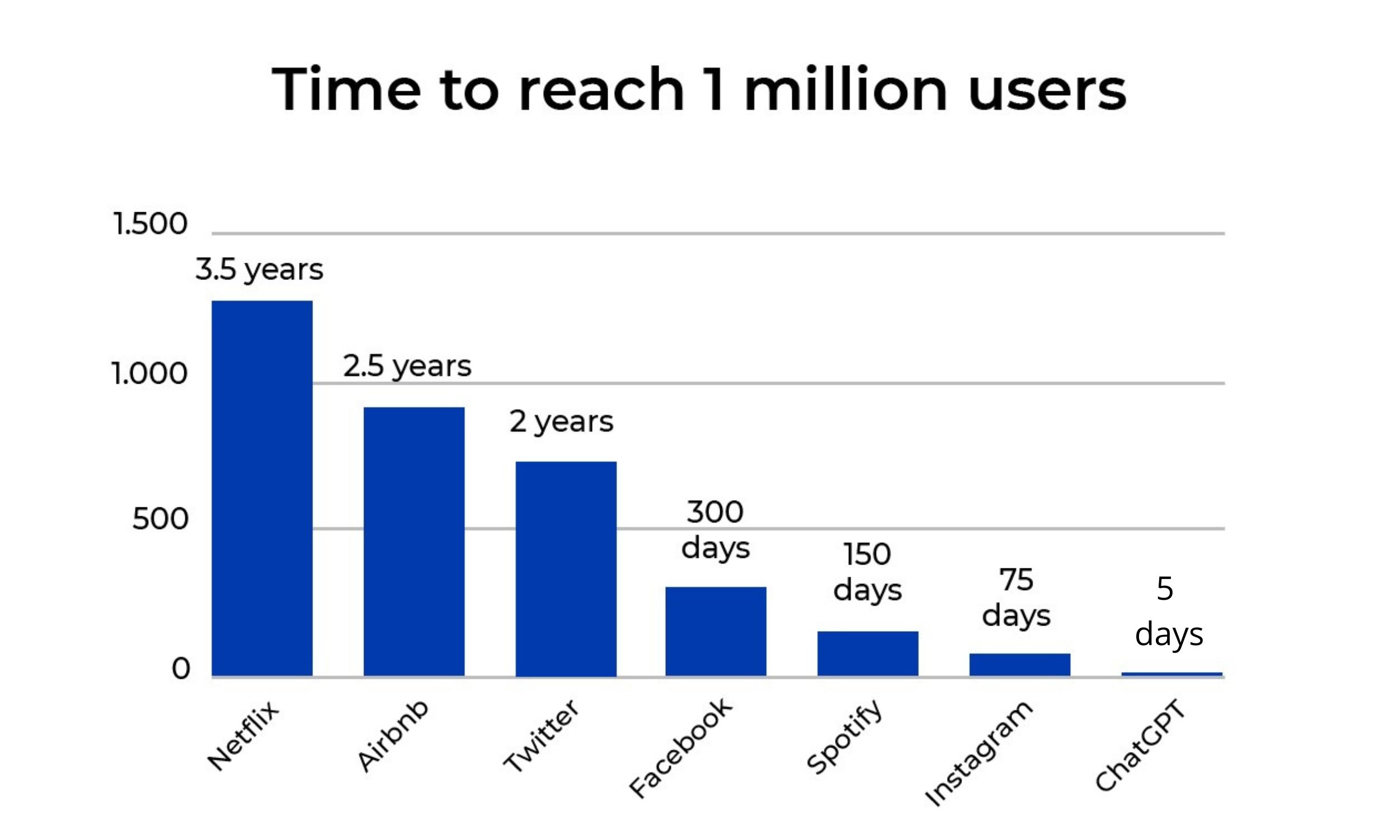
Source: Statista
Multimodal AI
Most traditional AI tools operate unimodal, meaning they process and generate output in a single data format, such as text, video, audio, or images. In contrast, the future of AI in SaaS is trending towards multimodality — a shift that will allow users to seamlessly input text or audio as a video or image prompt, significantly speeding up interaction with an AI system. Multimodality is recognized as one of the most impactful AI trends today, with a market anticipated to reach USD 4.5 billion by 2028.
Multimodal features empower ML and deep learning models to comprehend real-world environments similarly to human cognition. Trained on extensive datasets, these models excel in learning intricate relationships between data types, opening up new avenues in
Text-to-image synthesis
Image-to-text generation
Video-to-text analysis
Video-to-image generation
Training models across multiple data modalities simultaneously
Multimodal AI platforms can be categorized based on parameters, including
Input data modality (text, speech and voice, video, images, or audio).
AI technology employed (machine learning, NLP, computer vision, and context awareness).
AI type (generative, translative, explanatory, or interactive)
Business verticals (Banking, Financial Services, and Insurance (BFSI), telecom, marketing, retail, eCommerce, and more).
Multimodal AI in SaaS, applied in industries like healthcare, retail, and finance, is actively incorporating diverse data types. This enhances processes such as medical diagnosis and customer engagement, delivering more effective and personalized solutions across various sectors.
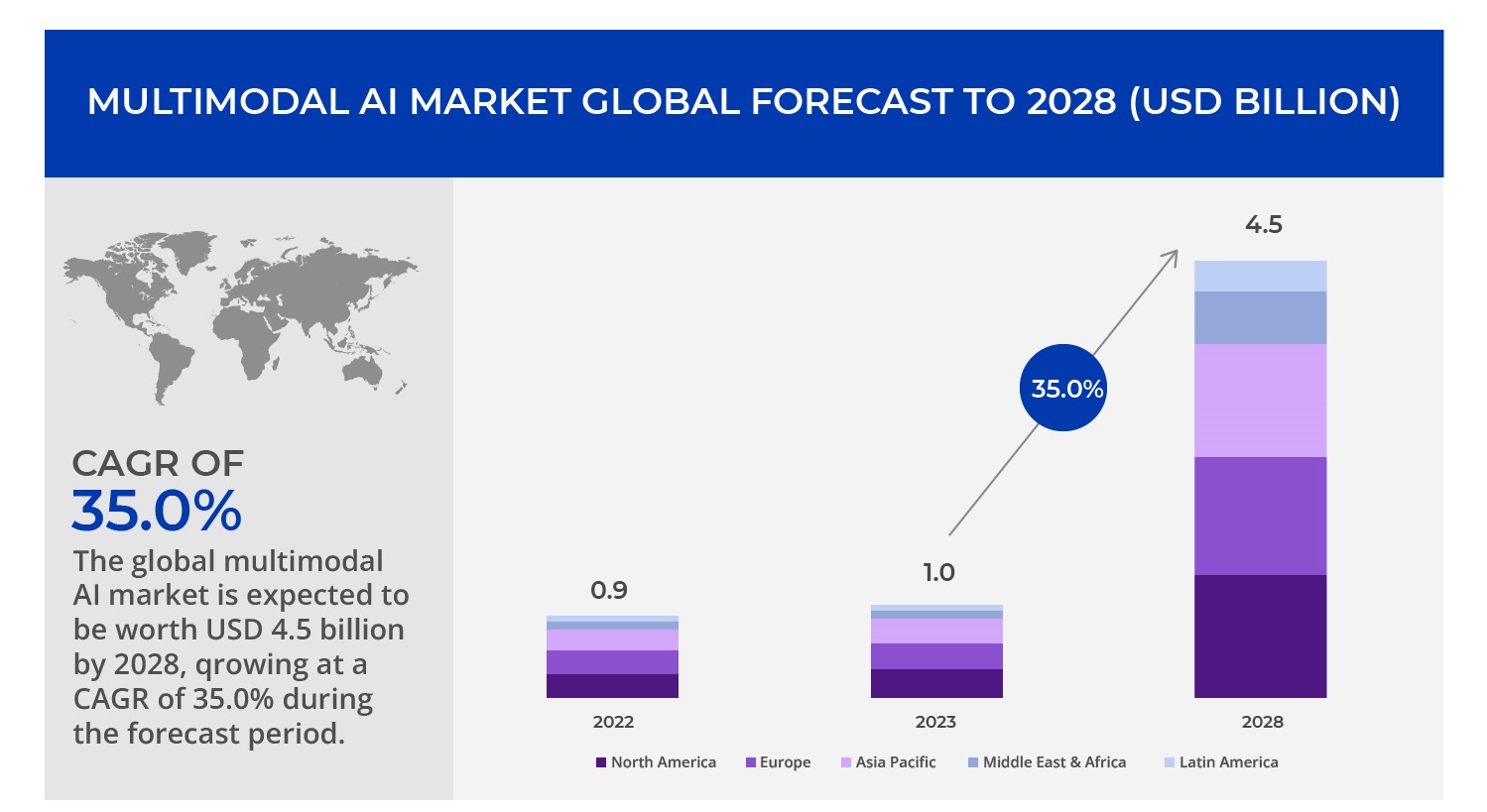 Source: Marketsandmarkets
Source: Marketsandmarkets
Customized Generative AI Models
While there's no one-size-fits-all AI solution, major tech players are adapting by allowing customization of generative AI models. This shift is crucial for companies eager to train AI to communicate in their own style and make decisions based on proprietary data. Customization empowers businesses to fine-tune AI algorithms for specific tasks, tailoring training data and adjusting parameters to achieve optimal results.
This is another vibrant field: generative AI frameworks were among the top 10 most popular GitHub projects in 2023, as stated in the above-mentioned GitHub’s Octoverse report. With investments into GenAI startups more than quadrupling in 2023 (USD 20+ billion compared to USD 5.1 billion in 2022), 2024 holds great promise for entrepreneurs. As Don Butler from Thomvest Ventures puts it,
“Startups have the ability to build better systems but face the difficulty to access the needed data. Enterprises have such consumer data and the infrastructure needed to manage it. A combination of these factors can make generative AI startups valuable mergers and acquisitions (M&A) targets in 2024.” — Don Butler, Managing Director, Thomvest Ventures
Nvidia NeMo is one example of a generative AI framework. Startups and corporations alike can use it to ensure the speed, privacy, completeness, and security of their data analysis. As a result, they get AI SaaS tools tailored to their specific data flows, datasets, and target outcomes.
Another example is Infinity, a generative AI platform we built for business intelligence startup Stotle. Infinity is a powerful toolkit for delivering customized AI-driven business analytics. Thanks to its built-in natural language generation capabilities, Infinity can provide in-depth explanations for any type of graphs and charts, making it easier to get insights from raw data quickly.
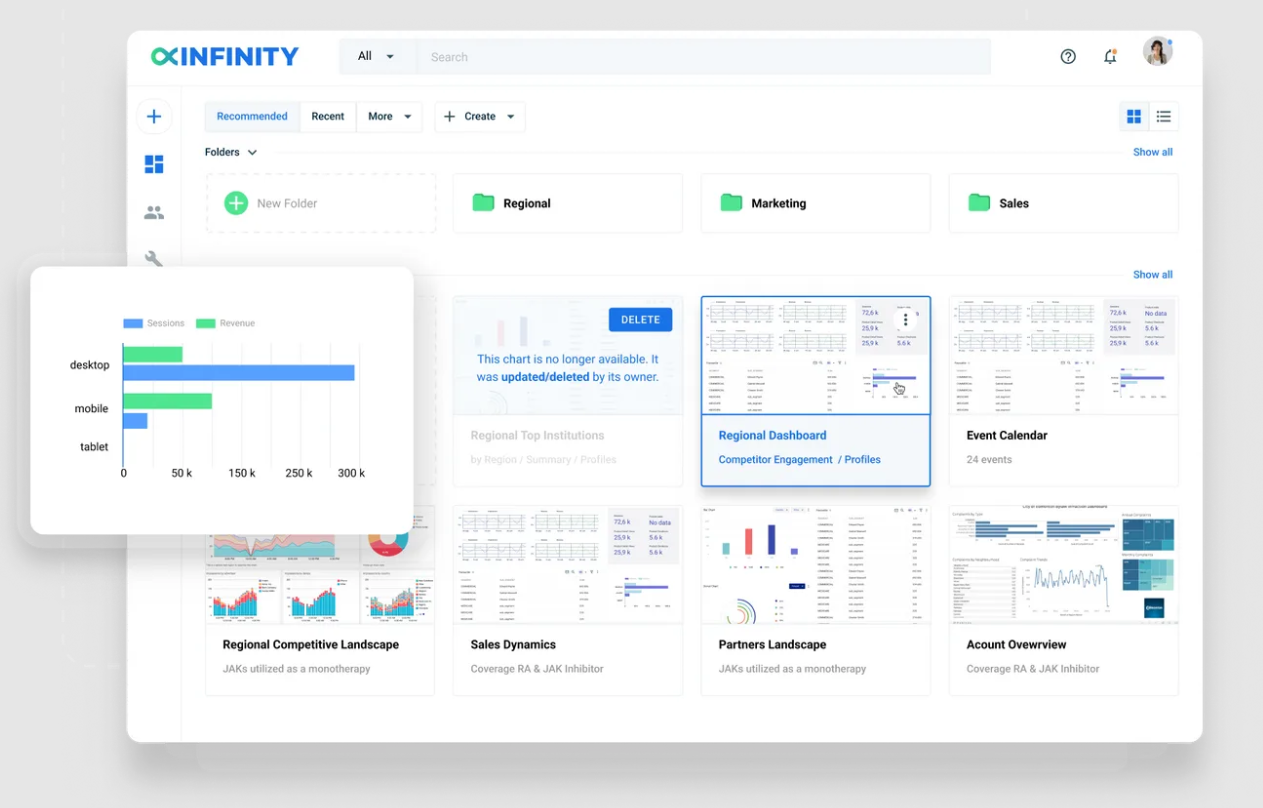
Infinity project dashboard
Federated Learning
Federated learning, a concept introduced by Google in 2017, is also emerging as a key trend in AI-driven SaaS. This approach transforms the conventional model of centralized machine learning by enabling its training across millions of decentralized devices. In other words, federated learning allows a model to be trained locally on individual devices such as smartphones, local servers, or IoT sensors, and only model updates are shared with a central repository.
Multiple advantages win this approach a place alongside trends in AI-driven SaaS:
Federated learning lightens system storage and computing requirements by distributing the training process.
With no centralized repository housing an entire dataset, it becomes more challenging for attackers to compromise the system, providing an added layer of security.
The decentralized ML model training approach solves the user data privacy challenge by preventing information sharing among competitors. It ensures that sensitive data remains on local devices, reducing the risk of unauthorized access and data misuse.
The scalability of federal learning makes it a perfect match for applications needing to handle extensive datasets across multiple devices and environments.
Local models contribute to a centralized learning process, harnessing collective intelligence for improved model performance.
A practical application of federal learning is in training recommendation engines for video streaming platforms. Here, federated learning can help build a holistic view of audience preferences without compromising the security of sensitive customer details.
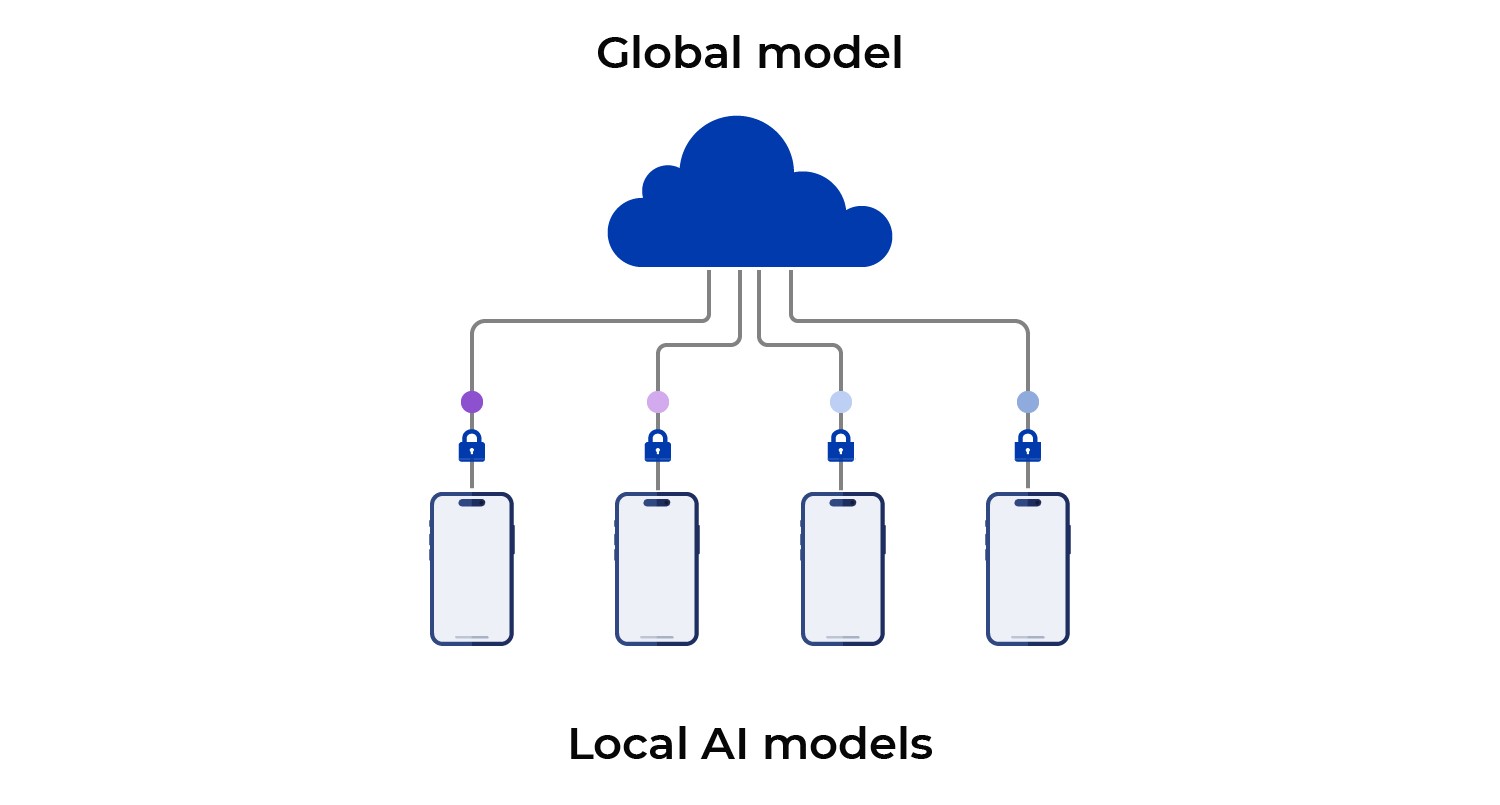
AI in Real-Time Video Processing
The COVID-19 pandemic forced businesses worldwide to shift to remote work, which made video communication essential to keeping teams in the loop. Still, ensuring good quality video during calls with 10+ people was challenging. As a result, many vendors began applying AI to improve the quality of real-time communication:
AI-driven Snapchat filters and lenses now help improve image quality during calls and streams.
Microsoft has developed a new video super-resolution feature for its Edge browser that will improve the quality of live calls and videos.
Nvidia uses AI in Omniverse to simulate physics and facial expressions in real time.
Video streaming platforms like Netflix also use SaaS applications with AI integration. From curating available content based on user preferences to dynamically altering video settings based on surroundings, video streaming benefits greatly from AI innovation. This is a particularly lucrative field, with the global video streaming market valuation expected to reach a whopping $417 bn in 2030, reflecting a CAGR of 21.5% over the next seven years.
These are the main innovative AI solutions for SaaS products in different domains. Let’s now turn to their real-world applications. Believe us: whichever domain you work in, these AI trends all have something to offer.
Most Popular AI SaaS Ideas in Different Industries
Smartphones were initially envisioned as “phones without keyboards”, but today, they support a myriad of revenue streams. The same applies to the AI SaaS ideas below: each one is effectively a foundation for a vast ecosystem of business models. As a result, any company that integrates AI with its products and services will be set to hold a big share of the pie in 2024 and beyond.
AI-Based Education Assistance
AI-based education solutions have broad applications thanks to the multiple stakeholders in the educational process: students looking for more individualized attention, teachers desperately needing more time and insights, and parents feeling in the dark about the specifics of their child's learning journey. More specifically, AI SaaS solutions can help with
Task automation and AI-based assistance. From grading tests to scheduling and attendance tracking, AI streamlines admin, allowing educators to reclaim valuable time and focus more on core teaching responsibilities. Through machine learning and natural language processing, AI can efficiently respond to student queries and suggest solutions.
Learning assistance outside the classroom. AI-powered chatbots or virtual learning assistants provide 24x7 support to students and parents. These virtual tutors address queries, offer feedback, and ensure personalized learning experiences without geographical constraints.
Personalized learning. AI tailors learning experiences by analyzing individual learning patterns, interests, and progress and building a tutor-like understanding of each student.
Smart content creation. AI can be used for effective content creation, including information visualization, real-time content updates, and digital lessons. AI enhances engagement by providing interactive visual experiences, incorporating recent and relevant themes, and delivering personalized learning materials.
AI-Based Content Generation
AI-driven content creation, exemplified by ChatGPT, dominates user considerations for AI tools, fueling a market poised for a staggering 900% growth between 2022 and 2032. In 2023, AI-written books became bestsellers on Amazon, an AI-written song gained traction, and an image drawn by DALL-E rivaled the quality of professional human photography.
Additionally, here are AI capabilities already in practical use, poised to form the foundation for innovative SaaS solutions:
Written content augmentation and creation. Enables streamlined content creation, allowing users to generate draft text outputs in desired styles and lengths.
Question answering and discovery. It can be the backbone for SaaS solutions to enhance information retrieval, enabling users to locate answers based on input data and prompt information.
Tone manipulation. AI-driven tone manipulation capabilities can be integrated into SaaS offerings, allowing users to alter text to suit various communication needs, from softening language to professionalizing it.
Summarization. SaaS platforms can leverage AI-powered summarization features to provide users condensed versions of conversations, articles, emails, and webpages, facilitating efficient information consumption.
Simplification. AI-driven simplification functionalities can assist users in breaking down titles, creating outlines, and extracting key content for improved content structuring.
Chatbot performance improvement. SaaS solutions can leverage AI to enhance chatbot performance, including sentiment extraction, classification across entire conversations, and generating journey flows from general descriptions, optimizing user interactions.
While AI appears to be an endless source of creativity across industries, it also presents corresponding challenges for creators and the public.
Artists decry the unauthorized use of their work by AI tools, the lack of respect for watermarks and royalties, and data scraping training methods. Actors are concerned about the unrestricted use of digital replicas in films. Studios with such replicas could effectively replace human casting, which would completely reshape content creation dynamics. Finally, legal disputes, including the New York Times suing OpenAI and Microsoft over copyrighted work, underscore the intricate landscape of AI content generation.
Despite these challenges, the allure of AI-based content generation persists, remaining one of the top manifestations of GenAI in business. Its evolution is likely to coincide with the emergence of new frameworks, such as 'TrustOps,' aimed at addressing concerns regarding trust, transparency, and accountability in AI-powered systems.
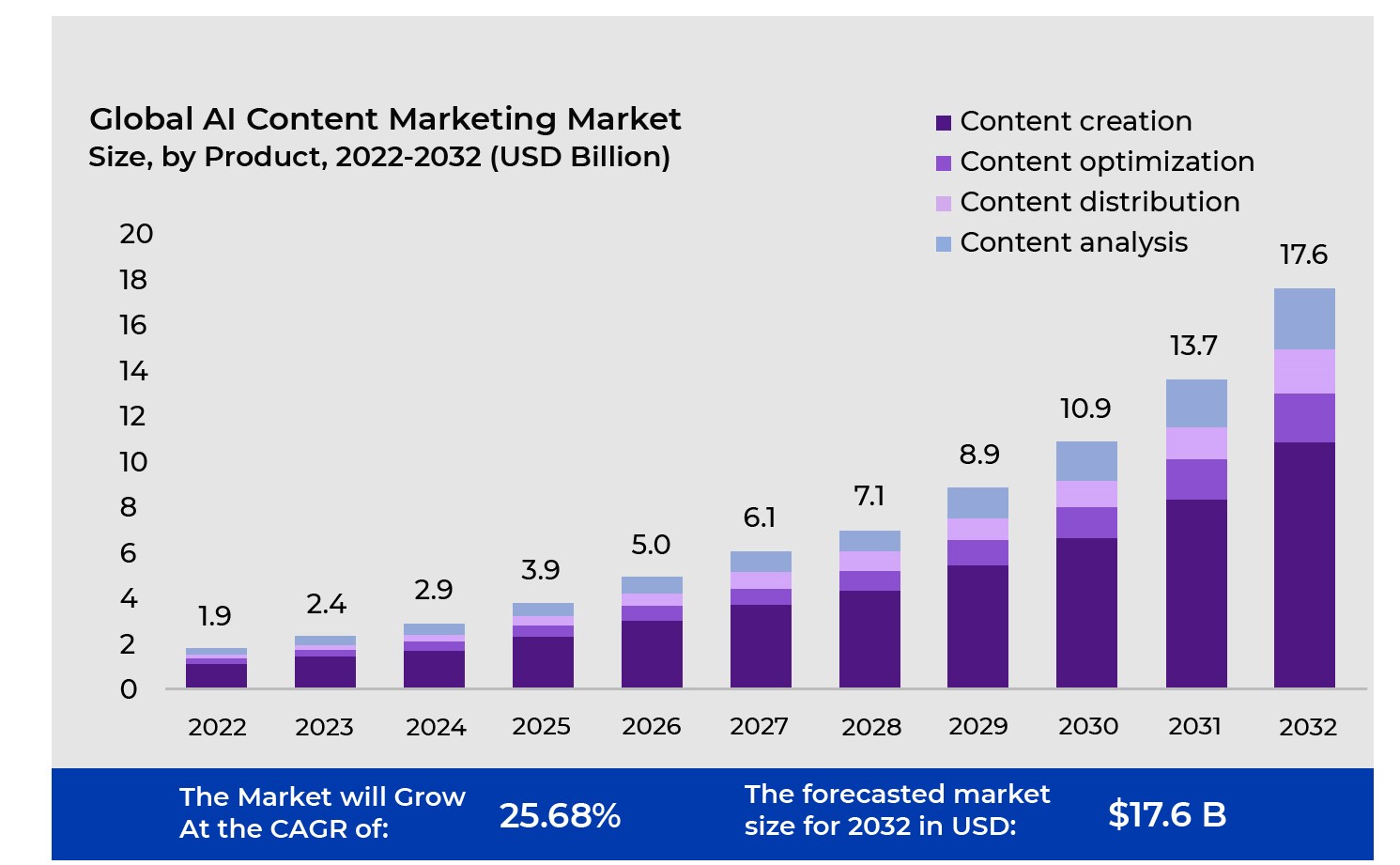
Source: Market.us
AI-Based Financial Assistance
In finance, accuracy is paramount, which makes AI automation of routine tasks particularly attractive. Here are the critical aspects of success in financial advisory, along with how ChatGPT-like tools perform in each:
Impartiality. AI-based financial assistance tools employ diverse training data, debiasing techniques, ongoing monitoring, explainability features, user feedback loops, and ethical guidelines to ensure fair and transparent financial recommendations.
Accuracy. Although it lacks human experience, ChatGPT has instant access to reliable financial databases like Morningstar, which enhances its ability to provide accurate, data-driven advice.
Best interest. In theory, AI, like ChatGPT, is less prone to conflicts of interest, as it doesn't seek to maximize income. Monitoring for conflicts of interest is likely more manageable with AI, as a tool can be corrected if it starts recommending costlier investments or mortgages without sufficient justification.
Consistency. AI-based financial assistance ensures better consistency as it is trained to give advice within the same financial category and similar situations, overcoming the potential inconsistencies seen in human advisors.
With continued development and refinement, AI-driven financial advisors are poised to become a prominent trend in AI-driven SaaS, offering enhanced and accessible advice services.
AI For Workflow Automation and Demand Forecasting in Retail
The AI in Retail Market size is expected to grow from USD 7.30 billion in 2023 to USD 29.45 billion by 2028. From POS behavior analysis to customer routes through stores and product tracking, computer vision and other AI-powered tools have the potential to significantly boost sales in retail.
When a vendor can forecast demand with high accuracy based on available data, they can select the optimal price range and form sufficient stock to maximize sales. Fast real-time data processing means retailers can adjust orders daily to avoid long delivery times or overpaying for empty storage.
AI-Based Medical and Healthcare Support
Healthcare SaaS industry advancements with AI benefit both clinicians and patients. It’s no wonder that the global market size for AI-powered SaaS platforms in healthcare is expected to grow nearly tenfold — from $19.7 billion in 2024 to $183.56 billion by 2030.
AI in healthcare has huge potential in areas as diverse as disease diagnosis, remote patient monitoring, and analyzing vast volumes of unstructured data. Existing AI applications include image analysis and combining data from electronic health records with medical imaging and real-time healthcare data to speed up diagnoses.
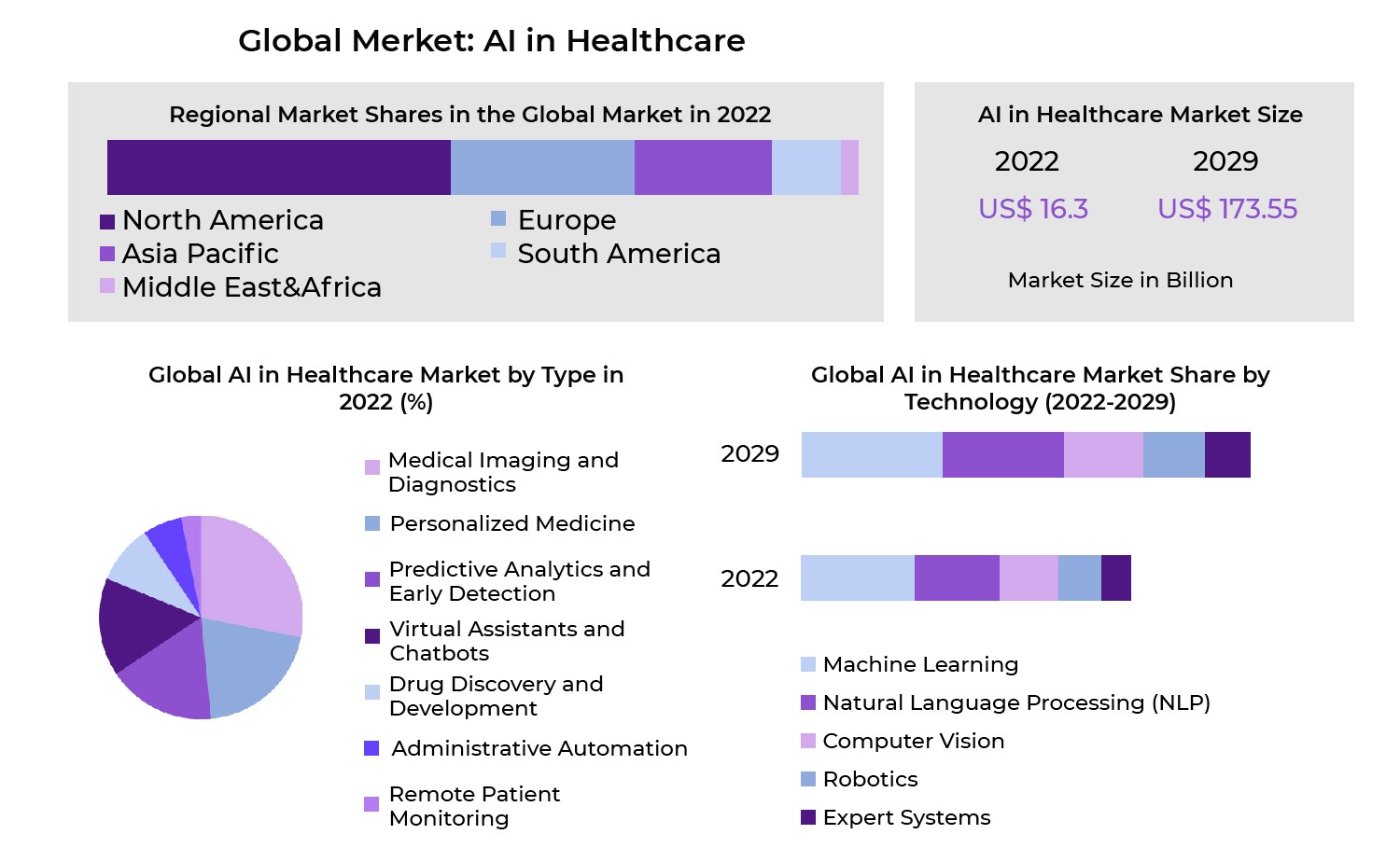
Source: maximizemarketresearch
AI-Based Cybersecurity
As mentioned above, a combination of AI and cybersecurity can significantly improve outcomes for both conventional and quantum computing. The global market valuation for AI platforms in cybersecurity is expected to grow nearly threefold, from $22.4 billion in 2024 to $60.6 billion in 2028. But there are two sides to the coin: face detection, for example, helps with user identification, but deepfakes are used by hackers to commit fraud.
“There are huge increases in cyber activity, as fraudsters adopt large-scale language models and deep fakes as their hacking tools.” — Thomas Crane, Managing Director at Insight Partners Business Insider article
AI can be deployed to analyze incoming data streams in real time to detect a cyberattack sooner and recover from it quickly. IBM’s 2023 Cost of a Data Breach report shows that organizations that deployed AI-driven SaaS platforms in their cybersecurity departments saved at least $3 mn on losses due to a breach.
InventorSoft has already participated in developing a highly performant cybersecurity system, enabling an in-depth overview of the existing code and cloud infrastructure vulnerabilities. This system enhances security measures by analyzing incoming data streams in real time to detect cyberattacks earlier and facilitate quicker recovery. Learn the details here.
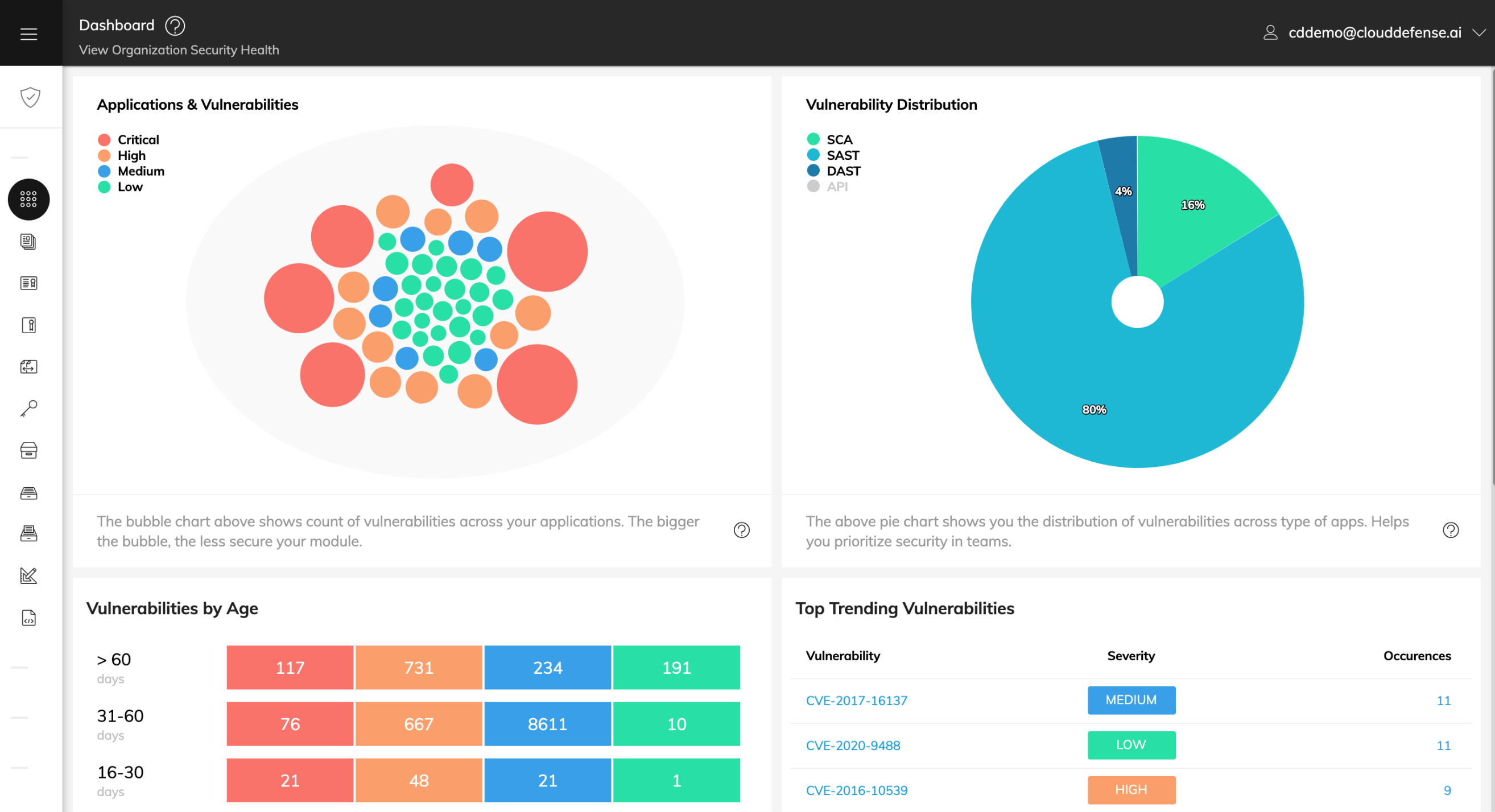
Cloud defense project dashboard
To Sum Up
The AI boom in SaaS is just getting started. Tech companies across the board offer AI services with capabilities tailored to your business needs. From quantum AI to multimodal AI or customizable generative AI algorithms, there’s developing tech to help with every task you face.
What’s more, AI in SaaS serves many domains ranging from education and content creation to finance, healthcare, and cybersecurity. All you need to use AI to the fullest is an in-depth understanding of the goals you want to achieve, the limitations of each AI model, and the best way to deploy and configure these tools.
At InventorSoft, we’re here to share our expertise. Contact us to discuss your AI integration ideas, and let us support you in getting them to market!
Related articles

12 Supply Chain Technology Trends To Watch In 2023

Features and benefits of WebSocket

Top 10 Benefits of Progressive Web Apps (PWA)
- AI Trends in 2024
- Most Popular AI SaaS Ideas in Different Industries
- To Sum Up
